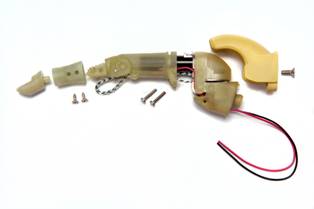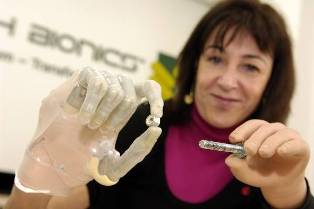World's first bionic finger restores grip for partial-hand patients
9 December 2009
Scottish company Touch Bionics, which developed the well-known i-Limb bionic hand, has now launched the world's first powered bionic finger for patients with missing fingers.
The ProDigits system has the ability to bend, touch, pick-up and point. Used within an overall prosthesis, it reflects the function of a natural hand.
It extends life-changing technology to partial-hand patients, whose finger absence is either due to congenital anomalies or amputation from a traumatic incident or medical condition.
The amputee population that can benefit from ProDigits is considerable, estimated at around 40,000 in the US and 1.2 million worldwide, and until now, these people have had no commercially available powered prosthetic solution open to them.
Not having fingers or a thumb to act in opposition to one another makes simple tasks such as holding a fork or a cup difficult and frustrating. The articulating digit underpins much of ProDigits' technical advantage and it is this articulation that provides the biggest benefit to the patient.

The components of a ProDigits finger
The nature of each partial-hand patient case is unique, and therefore each prosthetic build is also unique. The concept behind ProDigits is something never before commercially available in the prosthetics industry. Sockets are custom-designed and fabricated by clinicians to suit each individual's specific needs.
"Vocational and social reengagement is very important to a patient's rehabilitation after a traumatic event. Partial-hand injuries are, by their nature, challenging aesthetically and functionally," said Stuart Mead, CEO, Touch Bionics. "With ProDigits, our goal is to provide all that we can to reinstate a patient's function and interaction with other people in their chosen lifestyle and career."
Because of the personalized nature of each ProDigits fitting, Touch Bionics is developing a clinical collaborator program in North America that will see the company partner with practitioners in order to fit patients. Around the world, Touch Bionics has established relationships and distribution channels in over 40 countries to support the roll-out of ProDigits, supported from its Centre of Excellence in Livingston, Scotland.

Patient Maria Iglesias holding a nut with ProDigits
"Partial-hand amputation represents the largest group of arm amputees, and with ProDigits we finally have a functional state-of-the-art myoelectric prosthesis that we can offer this previously underserved amputee population," said Jack Uellendahl, C.P.O., clinical prosthetics specialist, Hanger Prosthetics and Orthotics.
"With ProDigits, each finger is capable of being a standalone functional unit, allowing for fitting of many different configurations of hand absence. In addition, the movement of the ProDigit prosthesis is natural in appearance, delivering a more elegant solution to partial-hand restoration than previously possible."
There are two control strategies that can be employed to power ProDigits: either myoelectric sensors that register muscle signals from the residual finger or palm, or a pressure sensitive switch input in the form of a force sensitive resistor (FSR), or touch pad, which relies on the remnant digit or tissue surrounding the metacarpal bone to provide the necessary pressure to activate the finger.
As with the i-LIMB Hand, a unique stall feature allows the device to detect when it has closed around an object, also allowing users to point single digits and configure the hand in various grip patterns.
Touch Bionics offers a range of coverings for ProDigits. For some patients the high-tech clear and black robotic skins offered by the company create a confident and highly functional solution. Others prefer a Livingskin option — a high-definition silicone solution that provides a human-like restoration to the combined limb and prosthesis for a comprehensive prosthetic restoration.